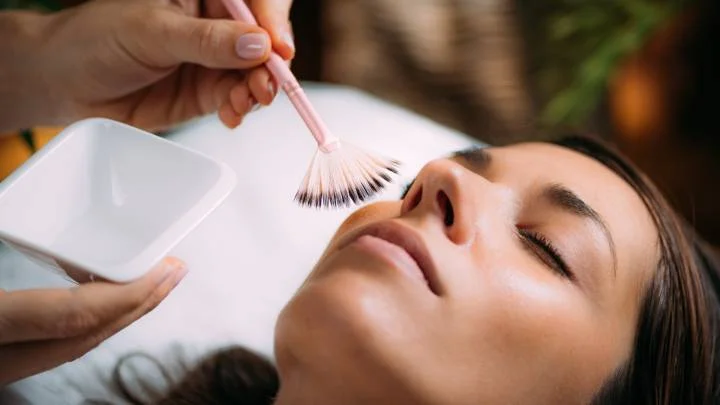A chemical peel is a non-invasive cosmetic treatment in which an acidic solution (with a pH less than seven) is used to remove damaged top layers of skin to encourage new collagen formation and improve skin tone and texture.
Chemical peels are popular with both male and female patients because they alleviate acne, fine lines and wrinkles, scars, hyperpigmentation, sun damage, and uneven areas of skin, giving the skin a more youthful and rejuvenated appearance, shares Dr. Rasya Dixit, an expert dermatologist who provides Chemical Peel Treatment in Bangalore at Dr. Dixit Cosmetic Dermatology Clinic.
Glycolic acid, salicylic acid, lactic acid, reti-noic acid, phytic acid, trichloroacetic acid, maleic acid, and carbolic acid are some of the acids frequently used in chemical peels. Although the names "chemical" and "acid" may seem frightening, it's important to know that all of the acids used in chemical peels are naturally collected from plants and, in many cases, are fruit extracts. Based on the type of skin concern and skin type the Chemical Peel Cost in Bangalore is decided by the doctor.
Chemical peels can help with skin issues such as acne scars, hyperpigmentation, fine lines and wrinkles, and uneven skin texture. However, they may not be appropriate for people with certain skin conditions, such as eczema or rosacea, and they can also induce transient side effects like redness, swelling, and peeling.
In this blog chemical peel dermatologist, Dr. Rasya Dixit has shared about types of chemical peel and one can also consult her at Dr. Dixit Cosmetic Dermatology Clinic to learn more on chemical peel prices in detail.
The Different Types of Chemical Peels
Chemical peels differ depending on the acid(s) used and the concentration of the acid in the solution. at Dr. Dixit Cosmetic Dermatology Clinic provides different chemical peels that are custom-blended for each patient by the skin expert to provide specific results based on the patient's goals.
Here's an overview of the different types of chemical peels:
1. Superficial Peels
Superficial peels treat very fine wrinkles, dry skin, mild to moderate acne, and skin pigmentation anomalies with alpha-hydroxy acids (AHAs) such as glycolic, lactic, maleic, citric, and tartaric acid. Beta-hydroxy acids (BHAs), like salicylic acid, are also used in superficial peels.
(a) Glycolic peel: The glycolic peel penetrates the skin the deepest of all the peels available, making it the best for exfoliation. This is because glycolic acid has a tiny molecular structure that allows it to penetrate deep into the skin's layers. It's also useful for restoring a healthy glow to ageing skin. Glycolic acid is used to break down and slough off dead skin cells. The result is smoother skin with clean pores or beautiful skin. Glycolic chemical face peel vary in strength and may influence the skin differently depending on how strong they are.
(b) Lactic acid peel: Some of the peels may irritate the skin if it is sensitive. One could consider a gentle chemical peel, such as a lactic peel. Lactic peels are derived from milk, as the name implies. It's not only gentle on sensitive skin, but it also moisturises dry skin.
(c) Jessner peel: A Jessner peel is a superficial peel used to treat sun damage and hyperpigmentation. This is ideal for all skin types, including those with thick skin. Jessner peels have been shown to reduce oil production on the face and treat acne. This chemical peel can be applied to the face, hands, neck, and upper chest.
(d) The alpha-hydroxy acid peel: The alpha-hydroxy acid peel will retexture the skin, improve skin tone, and improve acne-prone skin. Citric acid, glycolic acid, lactic acid, malic acid, and tartaric acid are the five fruit acids most commonly used in alpha-hydroxy acid peels. To reveal new skin, old skin is shed. This type of chemical peel is frequently recommended for those who show signs of ageing and will take approximately 20 minutes to complete. Depending on the severity of the problem, each peel has a strength ranging from 20 to 70%. Because this is a superficial chemical peel, it can be repeated every one to two weeks. Peeling typically occurs a few days following the procedure, and the skin may be pink as a result.
2. Medium Peels
A medium-depth peel uses a stronger acid, such as trichloroacetic acid (TCA), to penetrate the skin and remove damaged cells. This peel can help enhance the appearance of deeper wrinkles, acne scars, and sun damage. It can cause redness, peeling, and transient discolouration and might require some downtime for the skin to heal. TCA is frequently coupled with salicylic acid to generate a medium peel that targets acne.
A TCA peel removes the skin's topmost layers with a solution containing trichloroacetic acid. This type of peel is usually done at a clinic or doctor's office and can be used to treat a variety of skin issues, such as acne scars, sun damage, wrinkles, and hyperpigmentation. TCA peels can be done at various depths, ranging from very superficial to deep, depending on the desired results. These peels are often referred to as "lunchtime peels" because they can be performed quickly and with little to no discomfort.
Aftercare for Chemical Peels
To help the skin heal after any type of chemical peel, proper skin care will be required. The skin should be cleaned regularly with water or a dermatologist-recommended special face wash. If medium or deep peels have been performed, the ointment must be replaced. Daily moisturising is recommended, and sun exposure should be avoided until the skin has completely peeled. Daily use of sunscreen is required.
If you live in Bangalore and are searching for a dermatologist who provides chemical peels near me, then you must visit Dr. Rasya Dixit, at Dr. Dixit Cosmetic Dermatology Clinic, the best skin clinic in Bangalore.


